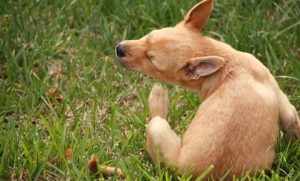Nutrition, Skin, and Dogs
 My dog sheds all the time and sometimes he gets sores where he has chewed himself. My veterinarian says he may have allergies and that he may need to eat a special diet. How can his diet make a difference in his skin and haircoat?
My dog sheds all the time and sometimes he gets sores where he has chewed himself. My veterinarian says he may have allergies and that he may need to eat a special diet. How can his diet make a difference in his skin and haircoat?
As far back as 1953, veterinarians recognized the relationship between nutrition and the state of health of the skin and haircoat. In a veterinary dermatology textbook from that era, we find the following quote:
“Dermatoses (skin diseases) affecting various species of animals are more commonly associated with malnutrition than they are with… a good state of nutrition.”
Approximately 25% of dog visits to the veterinarian involve problems with the skin and haircoat. The most common skin problems in dogs are:
- Allergy (including flea-bites and inhalant allergies)
- Skin cancers
- Bacterial skin infection (often secondary to allergy)
- Food hypersensitivity/intolerance
- Seborrhea
- Parasites (e.g. demodectic mange)
- Immune-medicated skin disease
- Hormone-related skin diseases
Even in dogs not experiencing an adverse reaction to food, the skin and haircoat can be affected by many nutritional factors.
A nutritional deficiency can have a huge effect on a dog’s skin and haircoat. This often happens when a dog is fed a homemade diet over a long period of time. A nutritional deficiency can also occur when dogs are fed a poor quality commercial dry food, a commercial food that contains nutrient excesses, or if a commercial diet is supplemented inappropriately.
A dog’s age is important when considering a potential nutritional problem with skin and haircoat quality. The dog’s body requires higher levels of certain nutrients during growth than during adulthood. Because the body has only so many ways to respond to diseases or nutritional deficiencies, it is important to look for and address any systemic diseases or parasites that may be at work. Nutritional issues should be considered if any of the following changes in the skin and haircoat emerge:
- Sparse, dry, dull hair with “split ends”
- Slow growth or no growth of hair from spots that have been clipped or shaved
- Accumulation of dry skin scales
- Pressure sores
- Change in or loss of hair color
Food-related risk factors for nutrition-related skin disease include:
- Lower fat content
- Poor quality protein or fat
- Lower nutrient digestibility
- High levels of some nutrients that can inhibit absorption of zinc (critical for normal skin)
How do protein and fat affect my dog’s skin and coat?
Protein and energy are needed for skin and haircoat development. If food does not have adequate protein or fat, then the dog may develop areas of hair loss, or the hair may lose color. The haircoat may become dry, dull, and brittle. For adult dogs, the protein level should be 25 – 30% on a dry matter (DM) basis, and fat should be 10 – 15% DM. For puppies, the protein should be 30 – 35% DM, and fat should be 15 – 30% DM. Overall digestibility should exceed 80%.
Another critical group of nutrients for good canine skin and haircoat quality are the essential fatty acids (EFAs). EFAs must be provided in the diet because the body cannot manufacture them. EFA deficiency causes the skin to become scaly and dry, the hair mats easily, and the skin loses its elasticity. Fortunately, EFA deficiencies are easily remedied by ensuring appropriate levels in the diet. Linoleic acid is one of the EFAs and should be provided at >1% DM.
How do minerals affect my dog’s skin and coat?
Finally, there are minerals that must be present in a dog’s nutrient profile in order to lay the foundation for good skin and haircoat quality. Copper deficiency causes a dull, dry haircoat with patchy hair loss and loss of normal hair pigment. The coat takes on a “washed out” appearance. Zinc deficiency causes hair loss, skin ulcers, and areas of skin thickening and cracking, particularly over joints and on foot pads. The skin-related signs of mineral deficiency clear up quickly with appropriate levels in the diet.
What if the problem is caused by something other than his diet? Can nutrition still help?
Another important way that nutrition can affect a dog’s skin and haircoat is when the dog is dealing with inflammatory or itchy skin disease. In these dogs, providing omega-3 fatty acids (FAs) from fish can make a dramatic difference. The omega-3 FAs modulate production of chemicals in the body that contribute to inflammation and itching in the skin. Omega-3 FAs have the greatest impact if the underlying causes of itchiness are controlled (e.g. flea infestation). In dogs with allergies, omega-3 FAs may allow for a dose reduction in the medications needed to control symptoms. It is important to choose a source of omega-3 FAs that is bioavailable- fortunately there are veterinary products formulated specifically for our canine patients, and your veterinarian would be happy to review them.
The data clearly shows a close relationship between nutrition and healthy skin and haircoat in dogs. It is important to prevent malnutrition – both by preventing deficiencies of nutrients as well as preventing excesses of nutrients. Your veterinarian is the very best source of information and guidance for choosing the most appropriate nutrient profile for your dog. Be sure to ask your veterinarian about any supplements you are considering. Nutrition for optimal health, wellness, and skin and haircoat quality is more involved than you may think!
